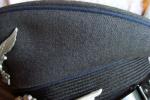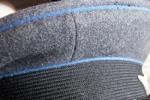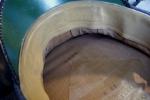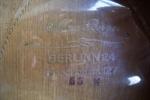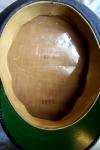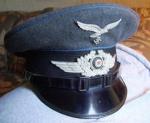
Harrier
Past Contributor-
Posts
432 -
Joined
-
Last visited
Content Type
Profiles
Forums
Blogs
Gallery
Events
Store
Everything posted by Harrier
-
Luftwaffe A couple of flight bars & some odds
Harrier replied to Wood's topic in Wehrmacht Medals, Decorations & Awards
Very nice pieces! The pin is a great indicator of the class of award when the finish is faded on zinc clasps, as the pins are made from an entirely different, non-absorbtive, metal. Like the pendants, too! If you ever want to get rid of any of the pendants, please let me know. Harrier -
Historic and beautiful pieces! Thanks for showing these. :beer:
-
Luftwaffe Unusal Pilot badge
Harrier replied to TheKnight's topic in Wehrmacht Medals, Decorations & Awards
That is very interesting and I would love to see such a badge! Thanks for the information! :beer: -
Luftwaffe Unusal Pilot badge
Harrier replied to TheKnight's topic in Wehrmacht Medals, Decorations & Awards
The only known originals of this badge were made by C.E. Juncker of Berlin and should be marked to that firm. Without very good close-ups of this badge, and exact dimensions and weight, it would be impossible to verify whether or not it is real. As usual, there are terrible copies and there are very good copies. The photo provided, however, is unfortunately useless to tell anything about this piece, one way or the other. -
As promised, I had hoped to post both my LW medical caps tonight so the darker piping could be shown (in comparison to the lighter blue posted earlier). I must apologize, as one of the two is in storage and I can't get to it right now. Here is the one I CAN get to. (The other is in storage because it is the same darker blue and I didn't need two of the same on display.)
-
Thanks for the comments. The blue is not faded. Here is a shot from the side. I have two LW medical visors and both have darker blue piping, although I agree that there are different shades of virtually all piping "types". This cap was a direct veteran purchase from a small town in Virginia in 1976. I always thought it was Transport.
-
Luftwaffe Flight bar... real or fake?
Harrier replied to Hauptmann's topic in Wehrmacht Medals, Decorations & Awards
You are entirely welcome. :D -
Luftwaffe Flight bar... real or fake?
Harrier replied to Hauptmann's topic in Wehrmacht Medals, Decorations & Awards
Fake made by Rudolf Souval of Vienna. -
Bundesrepublik knight's cross iron cross 1957
Harrier replied to Roeland's topic in Germany: Post 1945: Bundesrepublik & DDR
Now this is a really interesting point and one which deserves to be looked at. I have never seen a 1957 version cross with the 1st type ("A") frame with the 9-12 o'clock flaw. I can't say they don't exist, only that I have never seen one and I have looked at a lot. The ones that I have seen which don't have the "dent row" and the 6-9 o'clock "bridge flaw" ("B" type identifiers) always turn out to be the later, new, frame S&L created after the "B" die failed completely (probably in the late 60's or early 70's), and, on close examination, don't have the 9-12 o'clock flaw either. If such crosses exist, I can only imagine three scenarios for that existence: 1.) SOME "A" frames survived and were found, and utilized, by S&L; or 2.) The original "A" frame die was re-created from a "mother die"; or 3.) The original "A" frame die survived and was used again after 1957 to make crosses If scenarios 2 or 3 apply, I would expect to have seen very many 1957 crosses with the "A" frame (including the 9-12 o'clock flaw). If scenario 1 applied, I would think the number of such crosses would be very limited. Is there such an "A" frame 1957 cross, with 9-12 o'clock flaw, which can be shown here and closely examined? I am entirely open. -
Bundesrepublik knight's cross iron cross 1957
Harrier replied to Roeland's topic in Germany: Post 1945: Bundesrepublik & DDR
I will take that as a compliment. Thank you, Prosper. :) -
Bundesrepublik knight's cross iron cross 1957
Harrier replied to Roeland's topic in Germany: Post 1945: Bundesrepublik & DDR
When it comes to "B" type cross frames with raised beading flaws, I would agree with Prosper that these ALL appeared postwar. It is my PERSONAL feeling, as well, that at least most were actually stamped postwar. As far as the stamping is concerned, I say "most" because (again, in my personal opinion) there was at least one "die run" of the "B" type cross during the war and no one can know if the die deterioration might have occured during the course of that run, or not, and, in my opinion, S&L very likely had at least some stock of frames leftover for later use which escaped looting. (If it did not, it makes no difference in the end, as all "B" frames with raised beading flaws which have been offered for sale are, to me, postwar.) Very possibly, the die used to stamp the "B" frames was the repaired die originally used to stamp the "A" frames, and subject, because of those repairs, to more rapid deterioration. I am personally acquainted with "B" type crosses which came from American vets who were not occupation soldiers, but who returned to the U.S. in the Summer of 1945 for possible re-deployment to the Pacific, had zero interest in collecting after the war and who (being the parochial sort of people we are) never went to Europe again. As my friend Bob Hritz says: You can huff and puff until you are unconscious, but that is the truth and it won't change. The consensus today in the collecting community is that "A" type crosses constituted the vast bulk of all S&L crosses produced and awarded during the war. The further consensus is that the die used to produce these "A" crosses deteriorated and, that as a result of this deterioration, "A" type cross frames with raised beading flaws were actually delivered to the PKZ and awarded before S&L (or the PKZ, or both) decided that the point had come where the die could no longer be used, in its current state, to produce this high decoration of the Reich. This consensus is bolstered by a number of awards featuring the "A" type frame which seem to have excellent provenance and which have various stages of raised beading flaws and, further, by the total lack of any cross featuring the "A" type frame (whether with or without raised beading flaws) which can be established as coming from S&L (including the 1957 version) postwar. The dies which Prosper saw being offered for sale in London were, I believe, the "B" dies, which were, in turn, probably the repaired "A" dies, which had deteriorated even further by the time they were being offered for sale. S&L, for its remaining cross production, both swastika and non-swastika, used a new frame, which is the one we see today. Again, this is the consensus in the collecting community today, based on the information we have today, including BUT NOT LIMITED TO, the information from Dietrich Maerz. A significant basis to this is the acknowledgement of the existence of "A" and "B" types. This is not hard to verify and I have personally looked at dozens of S&L crosses and satisfied myself that the distinction is 100% valid. If you don't believe it, you can look yourself. I would be happy to be PROVEN wrong, as I personally already have the S&L's I want and am now looking for a few pieces a bit further afield. That's all for me. -
Bundesrepublik knight's cross iron cross 1957
Harrier replied to Roeland's topic in Germany: Post 1945: Bundesrepublik & DDR
I am glad to see that I am considered one of "the usual suspects"! This must be confusing to Dietrich Maerz, who has considered me one of the "usual suspects" in the opposite direction for quite some time now. Prosper, I have no reason whatsoever to doubt that you were present when flawed S&L dies were sold in London. I only wish those dies were available today for inspection, as they would be able to answer, in my opinion, an awful lot of questions. -
Bundesrepublik knight's cross iron cross 1957
Harrier replied to Roeland's topic in Germany: Post 1945: Bundesrepublik & DDR
Illuminating....... -
Bundesrepublik knight's cross iron cross 1957
Harrier replied to Roeland's topic in Germany: Post 1945: Bundesrepublik & DDR
I certainly hope not. You have indicated S&L had no leftover stock of RK frames and no thin sheeting because these were seized at the end of the war by the Allies. Let's clarify a few things here. The actual name of the document which led to the seizure of German assets was: "Agreement Between the Governments of the United Kingdom, the United States of America, and the Union of Soviet Socialist Republics, and the Provisional Government of the French Republic on Certain Additional Requirements to be Imposed on Germany; September 20, 1945" It provided as follows: "15. (a) The German authorities and all persons in Germany will hand over to the Allied Representatives all gold and silver, in coin or bullion forms, and all platinum in bullion form, situated in Germany, and all such coin and bullion situated outside Germany as is possessed by or held on behalf of any of the institutions or bodies mentioned in sub-paragraph 14 (a) above or any person resident or carrying on business in Germany." There is no language which states or requires that items "which can be melted down, re-processed and converted to bullion" will be handed over. If your interpretation was correct, Germans would have been forced to give up any jewelry, wedding rings, photograph frames, etc., etc., which could have been re-converted to bullion form. This simply did not occur (although certainly looting of such items by soldiers did occur and this became after the war, at least in the areas under the control of the Western Allies, an offense punishable by court martial). Under U.S. law and regulation, promulgated under the Comptroller of the Currency: "The term "bullion" refers only to uncoined gold or silver in bar or ingot form." Further, by this same regulation, these bars or ingots must have minimum purity levels as follows: Gold: 0.995 Silver: 0.990 Platinum: 0.9995 Similar laws and regulations are applicable in the UK and France. I have been unable to locate, in the English language, Russian requirements for purity of bars or ingots legally considered as "bullion". Neither the thin sheeting used by S&L (and others) in the manufacture of RK frames, nor the completed frames themselves, would ever have met the definition of, or qualifications for, "bullion". Further, I can find NO reference in any literature concerning the activities of the Allied Control Commission or its associated military units, that medal manufacturers, either in Ludenscheid or elsewhere, were targeted for asset seizure (although the Assmann firm did claim that British troops had destroyed some of their dies in an early "de-nazification" sweep). Similarly, a close friend of mine who is a researcher for the Holocaust Museum in Washington, and who has spent, literally, months going through Allied records regarding asset seizure, has confirmed to me that he has NEVER seen any such accounts. On the other hand, there are voluminous records of the seizure of gold and silver bullion and coins from German banks, financial centers, hiding places such as mines and vaults, and even trains. "Bullion", in ingot or bar form, was seized from some private firms whose work involved the actual further refining of those ingots or bars into other forms for military or scientific applications. The firms in Ludenscheid did not have that capability or equipment. As a final note, there seems to be a fundamental misunderstanding of flaws to the beading of S&L RK's, whether produced during the war or postwar. It is now generally accepted, based on Dietrich Maerz's work, that flawing of different identifiable type and location, can be found on S&L RK's. In one type of cross (which Mr. Maerz refers to as the "A" type) a flaw can be found at the juncture of the 9 and 12 o'clock arms of the cross. Additionally, and more importantly, the actual beading on the different arms of THIS type cross developed, over time, a series of defects, first on one arm, then spreading to others. The exact location of these various "beading flaws" can be "mapped", located with precision and identified. On another type of cross (which Mr. Maerz refers to as the "B" type), there are defects at the juncture of the 6 and 9 o'clock arms (referred to as the "bridge flaw", as there is an actual "bridge" of material extruding from the beading and crossing between those arms at this juncture), as well as what is called a "dent row" of indentations to the beading on the lower 3 o'clock arm, on the right hand side of that lower arm. This "B" type cross, with the "bridge flaw" and "dent row" (NOT found on the "A" type cross) ALSO developed over the time of its manufacturer (WHENEVER you might happen to believe this occurred) a series of defects in the beading on its arms, which (as with the "A" cross type) grew and spread, initially involving one arm and then visible on the other arms. These beading flaws on the so-called "B" type cross, as with the "A" type cross, can also be "mapped", located with precision and identified. Very plainly, these beading flaws are NOT located in the exact same positions as the beading flaws found on the "A" type cross, although, to the casual obsever, they "look" to be the "same". Whether you believe in Mr. Maerz's theories of the "timeline" of the manufacture of S&L RK's or not (and there are some parts I personally do not agree with)(as he well knows), it is indisputable, from a physical review, that the "A" and "B" types of RK frames identified by him do, in fact, exist, and are different from one another. Whether this is the result of the existence of one die (repaired) or two dies, or even more produced from a "mother die", is the subject of ongoing discussion and debate. These debates have viciously divided the RK collecting community into warring camps, which is unfortunate, as there is a great deal of knowledge to be discovered and shared, and now people feel compelled to only associate themselves with one camp or the other. I don't think it is that simple. At present, because no one can produce PROOF of an "A" type cross, with the 9-12 o'clock flaw, and whether with or without arm beading flaws, being produced by S&L in the postwar years, the argument seems to favor one repaired die. Any discussion of S&L RK's which merely classifies them into the two categories of 1.) a cross with no flaws or, 2.) a cross with flaws, is superficial and misses the point. The REAL discussion should be: WHEN was the "B" type introduced and how many versions of that type were produced during the war. This is so because no one has been able to show an "A" type, of any kind, which can be proved to have been produced subsequent to, probably, mid-1944. Awards of "flawed "A" types, with provenance, certainly occurred until the latter part of 1944 (although, again, it is not known exactly when these were produced). Of the "B" type, the 935-4 and 800-4 (both, of course, bearing the "4" number assigned by the PKZ to S&L) are believed by the bulk of the collecting community (although Mr.Maerz cannot confirm the 800-4) to be wartime productions, with the 935-4 having been reported by U.S. veterans to have been found both at Schloss Klessheim and from German prisoners. Other U.S. veterans report obtaining 800-4 versions from both German prisoners and from medal storage areas (which MAY have been the S&L factory or, possibly, Schloss Klessheim, as some of the same U.S. units were at both locations). Other respected collectors (and dealers) believe that a few other "B" models were produced wartime (including Bob Hritz, who has a non-"4" marked "B" type cross acquired by him from an American officer, who claimed to have acquired it from a German pilot who surrendered at Kitzingen, together with another cross, also acquired by Mr. Hritz from him, which was a Juncker with Godet Oakleaves, both confirmed as genuine, which the officer said was obtained at the same time, with supporting photos showing the officer with the pilots involved). Again, it is simply unknown when a particular cross frame was stamped, when the frames were assembled into a cross and when (in the case of wartime pieces) a particular cross would be pulled off the shelf for distribution. Of the over 7000 crosses awarded during the war (and even more manufactured) only a small minority have been viewed and subjected to any sort of intense scrutiny concerning the existence or non-existence of certain flaws. Mr. Maerz has stated that all crosses he has so far examined fit his "timeline", although others contend that crosses which might not fit the timeline have not been considered or, if considered, have been rejected simply because they do not fit the "timeline". Those arguments need not be re-hashed here. The important point is to acknowledge, as a basic step, that the "A" and "B" types do, in fact, exist, both with and without beading flaws. That is a physical reality and, whether or not you agree with Mr. Maerz on other issues, that discovery should be credited, in very great measure, to him. The "red herring" here is the attempt to lump ANY S&L RK with flaws into the "postwar" category and, then, to try to support this claim by reference to activity which simply did not occur according to records which are publicly available or to accounts of immediate postwar activities by those who were present in Ludenscheid at the time. We have NO IDEA how long flaws took to develop or how many frames were stamped at a time. It is entirely possible that flaws appeared and spread in the course of a single run or just a couple of runs. S&L may have conducted a repair and then made another "run", only to see other flaws develop in a similarly short time period with products from the repaired die (if there was such a thing). The truth is that manufacturers had leftover stocks of awards, both finished and unfinished, after the war, including RK's and their component parts and that, at some point, once their wartime materials stock was exhausted, commenced re-manufacture of those awards. A lack of frames and silver sheeting did not determine this time frame. Instead, that time frame was determined by stocks on hand and by "what they could get away with" in the political climate then-existing. By the way, I would love to see a Deschler PKZ marked RK, which I am unaware was ever awarded. I have heard of such a cross, in non-magnetic form, but wouldn't that violate PKZ core requirements after 1941? -
Bundesrepublik knight's cross iron cross 1957
Harrier replied to Roeland's topic in Germany: Post 1945: Bundesrepublik & DDR
Prosper, Again, I was talking about 1957 EK'S by Deumer, not RK's. Many EK's, as you know, have some SMALL degree of silver content in their frames (although very few would rise to the 800 level). The point seems to be, from what you are saying, that authorities seized silver in whatever form (sheets, frames, etc.) they could find. Would that be correct, regardless of the actual percentage of silver content? ("Bullion" generally has a meaning of 99.9% purity). Thanks, Harrier -
Bundesrepublik knight's cross iron cross 1957
Harrier replied to Roeland's topic in Germany: Post 1945: Bundesrepublik & DDR
I'm sorry, Prosper. I should have been more clear. Many medal firms would have had on hand quantities of both EK and RK frames. While the RK frames would mostly have been in the "800" category, and stamped from sheets of that grade of silver, some EK frames would also have been stamped from sheets with silver content. (I did not mean to imply that Deumer was an RK manufacturer, only that in making 1957 version EK's, they used frames which were stamped L/11, leading to the idea that these frames were wartime leftovers). Did the authorities ONLY seize silver of a certain content level? -
Bundesrepublik knight's cross iron cross 1957
Harrier replied to Roeland's topic in Germany: Post 1945: Bundesrepublik & DDR
http://gmic.co.uk/uploads/monthly_06_2009/post-2778-1245367340.jpghttp://gmic.co.uk/uploads/monthly_06_2009/post-2778-1245367320.jpg Nice to see 3 different S&L cores.

